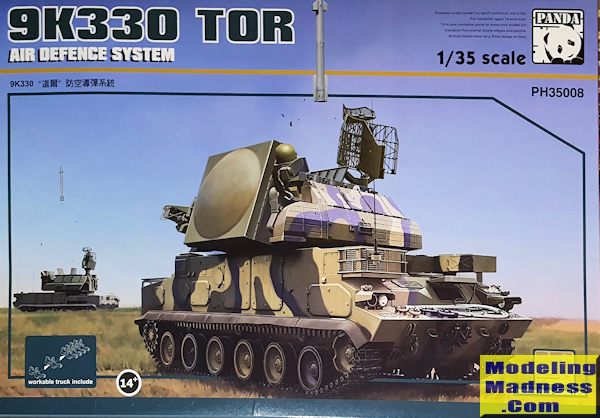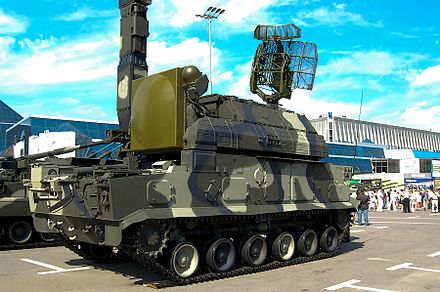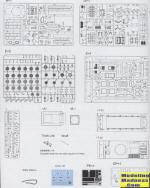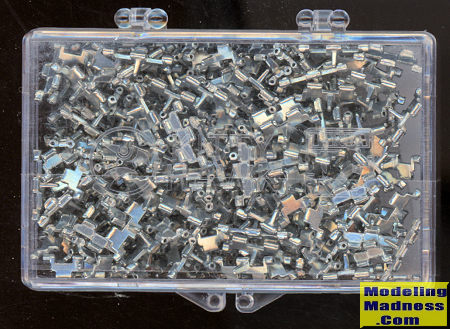
Panda Hobby 1/35 9K330 TOR Air Defense System
| KIT #: | PH 35008 |
| PRICE: | $ |
| DECALS: | one option |
| REVIEWER: | Scott Van Aken |
| NOTES: | Includes metal track links |

| HISTORY |
The Tor missile system (Russian: "Тор"; English: torus) is an all-weather low to medium altitude, short-range surface-to-air missile system designed for engaging airplanes, helicopters, cruise missiles, precision guided munitions, unmanned aerial vehicles and short-range ballistic threats (Anti-Munitions). Originally developed by the Soviet Union under the GRAU designation 9K330, the system is commonly known by its NATO reporting name, SA-15 "Gauntlet". A navalized variant was developed under the name 3K95 "Kinzhal", also known as the SA-N-9 "Gauntlet". Tor was also the first air defence system in the world designed from the start to shoot down precision guided weapons like the AGM-86 ALCM day and night, in bad weather and jamming situation. Tor can detect targets while on the move. The vehicle must stop intermittently when firing, although trials are being conducted to eliminate this restriction.
The project was given strict design specifications to meet; Tor had to provide extended detection and tracking of fast, low radar cross section targets and be capable of quickly and efficiently dealing with massed air raids, whilst providing a high degree of automation and integration with other air defence assets. In order to meet these demanding specifications, the designers used a variety of new technologies, including advanced Passive electronically scanned array radar for improved detection and tracking performance, enhanced digital information processing, and vertically launched missiles to improve reaction time and increase the number of readily available munitions. After a period of testing and evaluation between December 1983 and December 1984, the land based system was accepted into service on March 19, 1986.
Weighing in at 167 kg (368 lb), the 9M330 missile is
3 m (10 ft) long, carries a 15 kg (33 lb) warhead and has a peak speed of around
Mach 2.8 .
Utilizing command guidance and radar controlled proximity fuzes, the missiles
can maneuver at up to 30Gs and engage targets flying at up to Mach 2. Cold
launched, the missiles are propelled out of the vehicle before the solid fuel
rocket motor fires and the gas-dynamic maneuvering system turns them toward
their target. Missiles can also be fired against surface targets. Each missile
is a sealed round, stored in two groups of four. Engagement range is up to 12 km
(0.8-6.47 nm) with minimum range varying between 1500–2000 m (328-5,621 feet),
depending upon version and an effective altitude of 10–6000 m (33-20,000 ft).
.
Utilizing command guidance and radar controlled proximity fuzes, the missiles
can maneuver at up to 30Gs and engage targets flying at up to Mach 2. Cold
launched, the missiles are propelled out of the vehicle before the solid fuel
rocket motor fires and the gas-dynamic maneuvering system turns them toward
their target. Missiles can also be fired against surface targets. Each missile
is a sealed round, stored in two groups of four. Engagement range is up to 12 km
(0.8-6.47 nm) with minimum range varying between 1500–2000 m (328-5,621 feet),
depending upon version and an effective altitude of 10–6000 m (33-20,000 ft).
So far, the system has only been used in combat once, and that is still to be verified. In the 2008 South Ossetian War, Georgian 9K330 missiles are alleged to have shot down a Russian Tu-22 reconnaissance bomber. The plane was shot down, but the system which did so is still under debate. The system is supposedly also being used in Russia's current invasion of Ukraine.
This kit is for the initial production version. The type has since gone on through a number of modifications and upgrades since its initial production.
| THE KIT |
 To many companies, and Panda is included in that,
detail means a lot of small parts. It seems to be the going method of providing
what apparently modelers want in an armor kit. These folks leave it to Tamiya to
provide for other modelers. This kit is no exception. Let me start by letting
you know that this kit has individual track links and each link has a separate
guide pin. The links in this care are cast metal and ve
To many companies, and Panda is included in that,
detail means a lot of small parts. It seems to be the going method of providing
what apparently modelers want in an armor kit. These folks leave it to Tamiya to
provide for other modelers. This kit is no exception. Let me start by letting
you know that this kit has individual track links and each link has a separate
guide pin. The links in this care are cast metal and ve ry
nicely done. Each track is complete with the guide tooth molded in place. I've
shown them in their case as I didn't want to untape the box and possibly have
links all over the place in the box. The pins are in the box in their own bag. The twelve suspension attachment locations and suspension
items total eight pieces. The twelve road wheels are two piece constructs, so
you get the idea.
ry
nicely done. Each track is complete with the guide tooth molded in place. I've
shown them in their case as I didn't want to untape the box and possibly have
links all over the place in the box. The pins are in the box in their own bag. The twelve suspension attachment locations and suspension
items total eight pieces. The twelve road wheels are two piece constructs, so
you get the idea.
There is a
nicely done photo etch fret that includes brackets for the copper tow 'rope',
light guards, sections for the hatches, some waffle foot plate areas, screens
for
 engine intakes and grilles for what looks like a radio transmitter piece as
well as the reflector for the large radar array. All the photo etch pieces are
appropriate for the kit; in other words no attempt to represent radio aerials
and such.
engine intakes and grilles for what looks like a radio transmitter piece as
well as the reflector for the large radar array. All the photo etch pieces are
appropriate for the kit; in other words no attempt to represent radio aerials
and such.
The main body of the vehicle is a full one-piece lower hull and one piece upper section. There is no interior so any hatches are shown modeled closed, though I'm sure you can put them open if you wish to insert a figure. There are quite a few boxes of various sizes and shapes that fit on the upper hull and I've not a clue as to what most of these might be. I'm guessing storage units for the most part.
A very large turret is part and parcel of this vehicle and that is what contains the various radar arrays as well as the missile packages. These latter items are closed off so no missiles are included. They are also not hinged so you can only model them in the stowed position. The planar antenna on the back of the turret is fixed, but the forward tracking antenna array is not. This rather complex assembly gets two pages and it can be modeled either stowed or operating position. It appears that this is able to be posed either way, though the instructions do not provide any 'no glue' icons for the hinge. Interestingly, the final assembly sequence is the joining of the upper hull, lower hull and turret array. Usually one would join the upper hull much earlier. However, this will make it easier to paint the track assemblies.
 Instructions
are Panda's normal book style with superbly drawn construction steps. Typically,
there is no color information provided during construction. I often wonder what
it is about military vehicle kits that sees this information so often omitted.
The markings are minimal and for two vehicles. One is the box art vehicle in two
browns and a black. This only carries the five red warning markings. An overall
olive brown vehicle includes the tactical number. Judging from most photos I've
seen of these systems, they are devoid of tactical numbers. The small decal
sheet is well printed and should prove to be useful.
Instructions
are Panda's normal book style with superbly drawn construction steps. Typically,
there is no color information provided during construction. I often wonder what
it is about military vehicle kits that sees this information so often omitted.
The markings are minimal and for two vehicles. One is the box art vehicle in two
browns and a black. This only carries the five red warning markings. An overall
olive brown vehicle includes the tactical number. Judging from most photos I've
seen of these systems, they are devoid of tactical numbers. The small decal
sheet is well printed and should prove to be useful.
| CONCLUSIONS |
I know that builders of modern Russian military vehicles will be thrilled to get this one. Those who want a lot if detail in their kits will also be pleased. The detailing on the kit itself is superb and the end result will be a very impressive model of this weapon system.
| REFERENCES |
https://en.wikipedia.org/wiki/Tor_missile_system
December 2019 Copyright ModelingMadness.com.
All rights reserved. If you would like your product reviewed fairly and
fairly quickly, please
contact
the editor or see other details in the
Note to
Contributors.